Swipe, Scroll, Style – The Rise of Social Fashion Trends

The Social Media Fashion Revolution
Social fashion trends are rapidly evolving style movements that originate and spread through social media platforms, changing how we find, adopt, and share fashion.
What are social fashion trends?
- Styles that gain popularity primarily through platforms like TikTok, Instagram, and Pinterest
- Characterized by faster adoption cycles (sometimes just weeks vs. traditional seasons)
- Often driven by user-generated content rather than traditional fashion gatekeepers
- Heavily influenced by Gen Z values including sustainability, authenticity, and inclusivity
- Range from micro-trends (brief viral moments) to macro-trends (longer-lasting movements)
The gatekeepers of the fashion industry used to be editors, experienced designers, and powerful retailers—but so much has changed since platforms like Instagram launched in 2010. Today, anyone with a smartphone can potentially set the next global style sensation.
"Social media has a huge influence on all areas, and the fashion industry is no exception," notes research from our analysis of current market dynamics. This democratization has completely restructured how trends emerge and evolve.
With over 100 million images shared daily on Instagram alone and 84% of shoppers consulting at least one social media platform before making a purchase, these platforms have become virtual runways where trends spread at unprecedented speed.
What makes today's social fashion landscape unique is its participatory nature. Rather than passively consuming styles dictated by traditional fashion weeks, consumers actively co-create trends through hashtag challenges, styling videos, and digital mood boards. This has compressed trend cycles dramatically—what once took 1-2 years to reach mainstream adoption now often happens in mere months.
For brands and individuals alike, understanding this new ecosystem isn't optional—it's essential for staying relevant in a rapidly changing landscape where viral aesthetics like cottagecore, Y2K revival, and coquette can transform from niche to mainstream overnight.
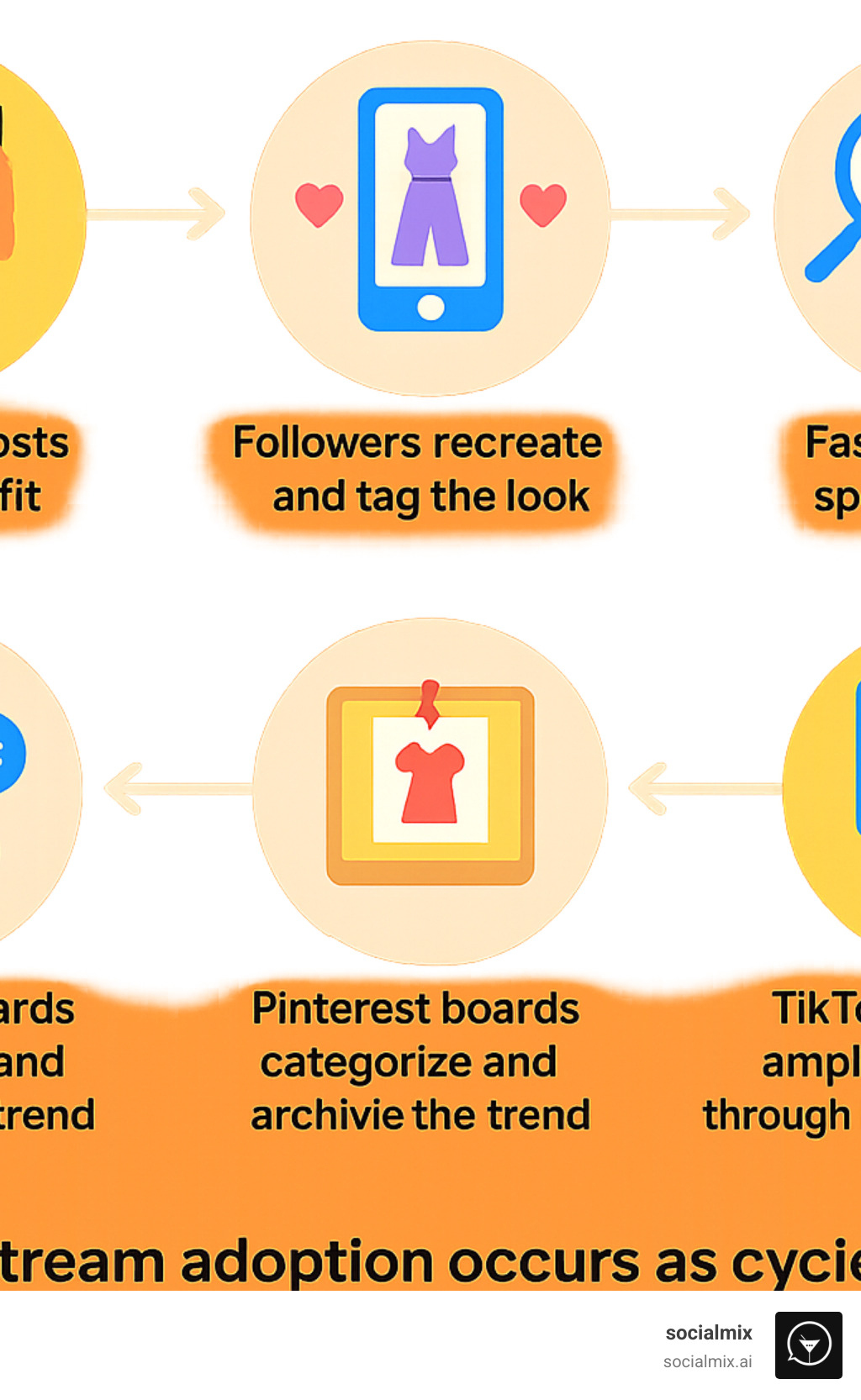
Decoding Social Fashion Trends: From Hashtags to Runways
Remember when fashion trends took months to travel from exclusive runway shows to your local mall? Those days are gone. Today, a casual TikTok post can transform into a global fashion phenomenon almost overnight, reshaping how we find and adopt new styles.
"The gatekeepers of the fashion industry used to be editors, experienced designers, and powerful retailers," as industry research confirms. But now, the power has shifted dramatically. Today's social fashion trends emerge through a fascinating dance between everyday creators, smart algorithms, and lightning-fast manufacturing.
How Trends Go Viral
When you scroll through your feed and suddenly notice everyone wearing the same style of barrel jeans or crochet tops, you're witnessing the modern trend cycle in action. This journey typically unfolds like this:
First, someone (maybe an influencer with millions of followers or just your stylish neighbor) posts a unique outfit. The platform's algorithm notices people are engaging with it—liking, commenting, saving—and pushes it to more viewers. Soon, followers start creating their own versions with personalized hashtags, amplifying the style further. Fast-fashion brands, constantly monitoring social media, quickly spot this momentum and rush similar products to market. Before you know it, the trend appears everywhere, becoming almost impossible to escape.
This acceleration has forced clothing brands to become incredibly nimble. Some women's fashion labels have slashed their design-to-shelf timeline to just one week to capitalize on emerging micro-trends. Using sophisticated image recognition technology and social listening tools, companies can now detect budding trends 6-12 months before they hit the mainstream.
"Social media has a powerful predictive capacity," industry experts explain. Rather than simply reacting after trends have exploded, brands analyze millions of images and engagement patterns to forecast which social fashion trends will gain serious traction. According to research on TikTok's role in social commerce, the platform has become a critical driver in accelerating trend adoption and purchase decisions.
Micro-trends vs. Macro-trends in Social Fashion Trends
Not all trends are created equal in today's social media landscape. Understanding the difference between fleeting fads and lasting movements can help you make smarter style choices.
Micro-trends burst onto the scene like fireworks—bright, exciting, and quickly gone. Remember when everyone suddenly started wearing boxer shorts as outerwear last summer? Or how the viral Tabis theft story made those distinctive split-toe shoes instantly desirable? These quick-hit trends typically last 90 days or less—barely enough time for traditional retailers to respond.
"Some micro-trends now take just a few months to be adopted by the population, compared to 1–2 years before social media," according to recent research. They create excitement but often lead to impulse purchases that quickly feel dated.
Macro-trends, by contrast, represent broader style movements with staying power. Think cottagecore, dark academia, or the Y2K revival—comprehensive aesthetic approaches that influence multiple seasons and product categories. These typically last 18 months or longer and often reflect deeper societal shifts.
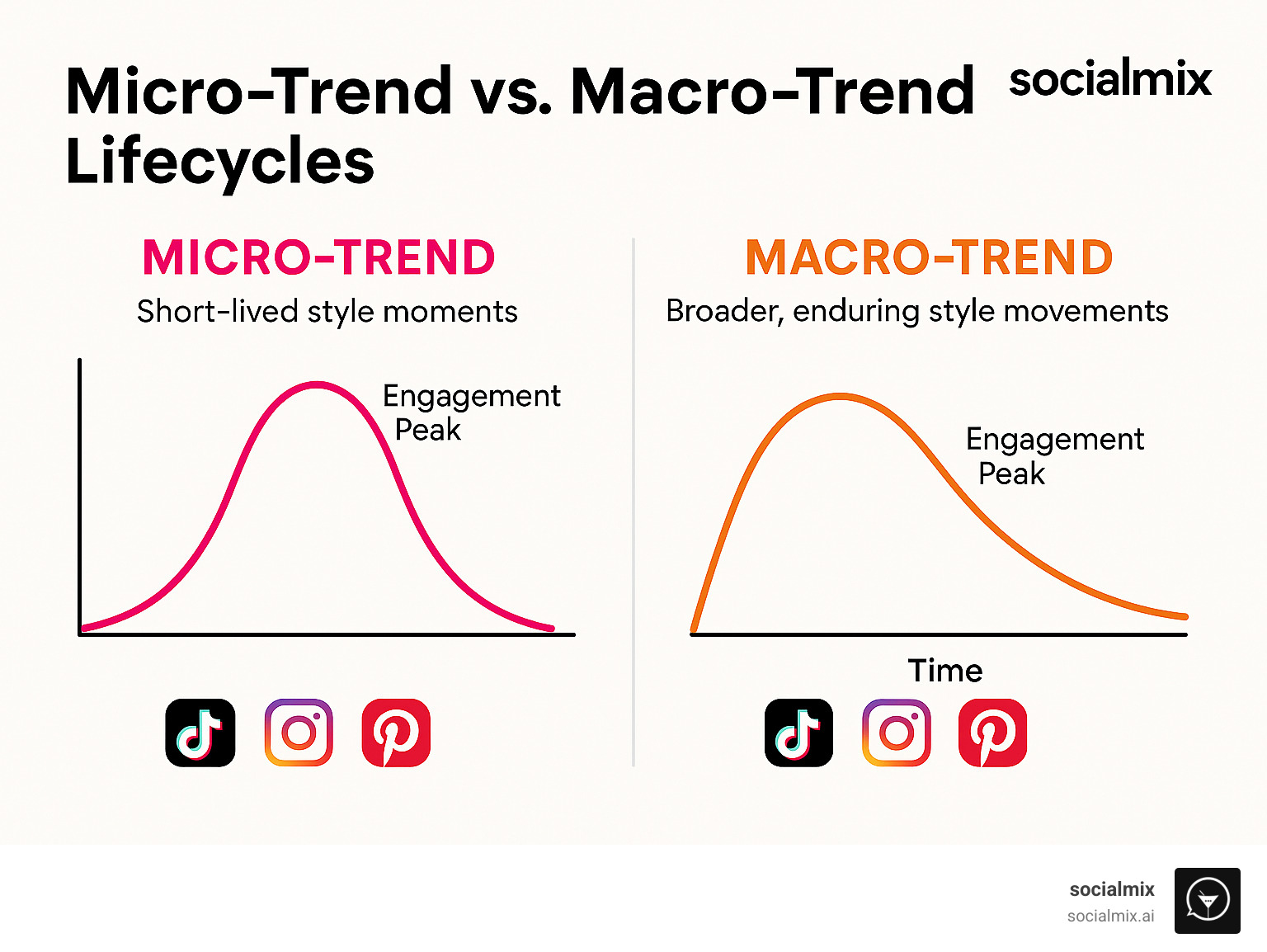
At socialmix, we find this distinction particularly meaningful for our cocktail-inspired collections. While we might incorporate trending elements like powder pink (a hot color for Spring/Summer 2025) or statement belts, our core designs align with macro-trends celebrating social connection, craftsmanship, and timeless elegance—values that never expire in either mixology or fashion.
The science behind trend forecasting has become remarkably sophisticated, with research on social media forecasting showing how data analytics can predict which styles will transition from runway to everyday wear. This predictive power helps brands anticipate resale spikes and adapt to consumer preferences before they fully materialize.
Whether you're looking to refresh your wardrobe with the latest viral aesthetic or invest in pieces with staying power, understanding how social fashion trends move from hashtags to hangers gives you the insight to make choices that truly reflect your personal style.
Influencers, Communities & The Acceleration Effect
The explosion of social fashion trends owes much to the rise of influencers who have become the new tastemakers of our digital age. What's fascinating is that in this new landscape, bigger isn't always better.
Micro-influencers—those with fewer than 35,000 followers—actually generate the highest engagement rates at about 5.3%. These smaller creators build genuine connections that feel more like recommendations from a stylish friend than a celebrity endorsement. When they style a particular accessory or showcase a new garment, their audience doesn't just admire—they're inspired to follow suit.
Trust is the secret ingredient here. Research shows that 91% of users trust other users' opinions over traditional advertising. That authentic connection is pure gold in today's saturated market.
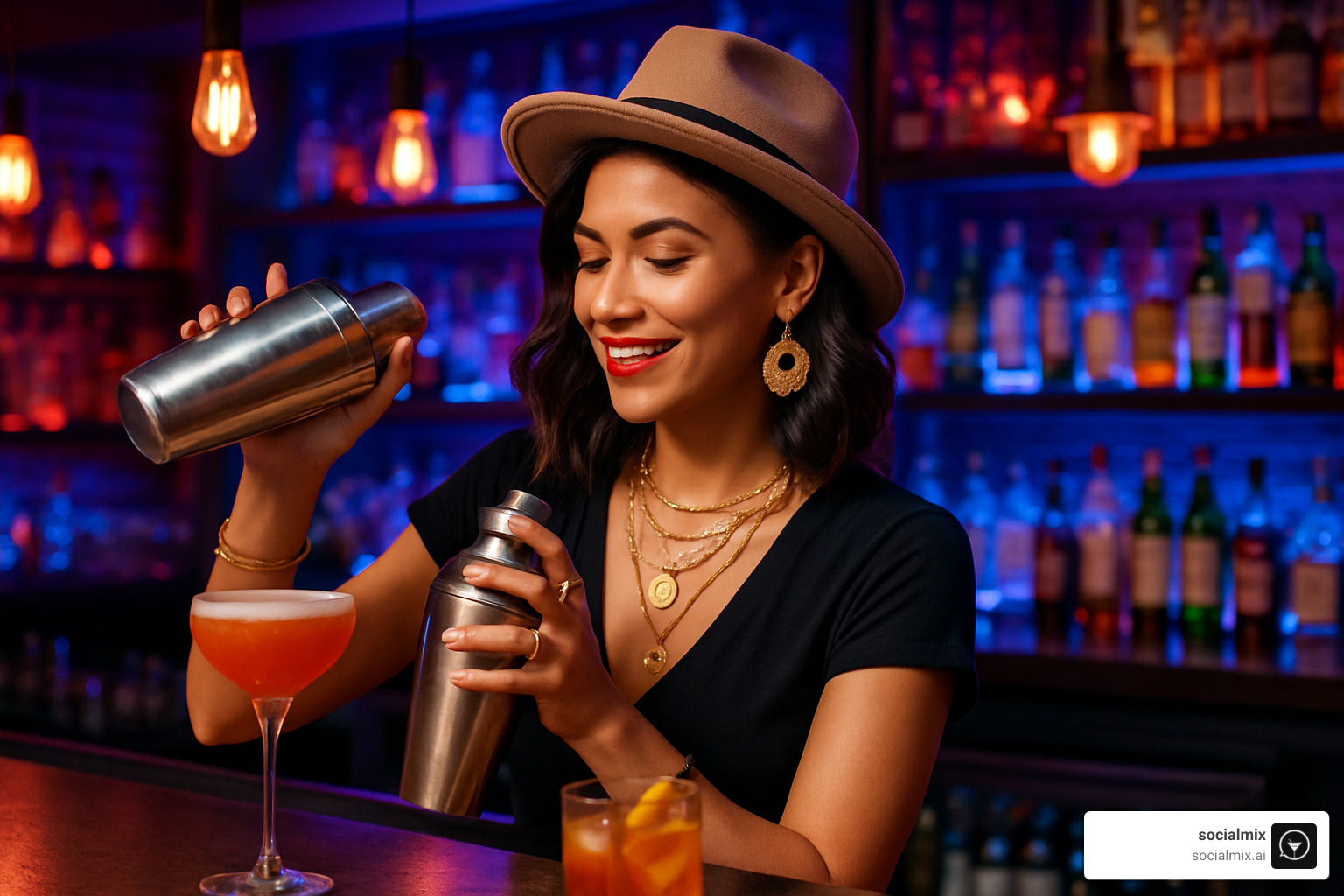
The real magic happens when multiple influencers adopt similar styles simultaneously. This creates a critical mass that signals to algorithms that something important is brewing. Just like a perfectly crafted cocktail gaining popularity across bars nationwide, these platforms amplify trending content to more users, creating a self-reinforcing cycle that can transform a niche style into tomorrow's must-have look.
Platform-Specific Social Fashion Trends
Each social platform has developed its own unique fashion ecosystem, each with distinct trend characteristics:
TikTok reigns supreme for rapid trend cycles. Its short-form videos and powerful algorithm can make styles go viral within hours. Those #OOTD (Outfit of the Day) hashtag challenges generate millions of submissions, with Gen Z embracing bold experimentation. Remember the recent "Frazzled English Woman" aesthetic that had everyone channeling their inner early-2000s British rom-com heroine? Pure TikTok magic.
Instagram remains the visual portfolio of choice for fashion enthusiasts. Its trio of feed posts, Stories, and Reels creates multiple touchpoints for trend findy. Unlike TikTok's item-focused approach, Instagram excels at showcasing complete styling ideas. With 70% of fashion brands using Instagram to promote products, it's become the crucial commercial channel where trends transform into immediate purchase opportunities through shopping tags.
Pinterest takes a more deliberate approach, serving as both trend incubator and thoughtful archive. Searches for "sustainable fashion" have jumped 71% year-over-year, highlighting how the platform reflects deeper value shifts in our relationship with clothing. Users create inspiration boards around specific aesthetics, planning future purchases rather than making impulse buys.
YouTube still dominates for in-depth content with its comprehensive trend analysis through haul videos, styling guides, and seasonal forecasts. The platform's longer format allows creators to explain the context and versatility of trends in ways that quick-hit platforms simply can't match.
Crowd Power: How Online Tribes Birth Trends
Beyond individual influencers, online communities have become powerful trend generators. These digital tribes gather around shared aesthetics and values, creating incubators for social fashion trends that eventually bubble up into the mainstream.
Discord servers dedicated to aesthetics like dark academia or cottagecore function as virtual workshops where members refine style approaches before they reach wider audiences. Subreddits like r/thriftstorehauls or r/streetwear serve as democratic trend validators, with upvotes signaling what might soon explode across Instagram and TikTok.
These communities particularly shine with DIY and upcycling trends. Gen Z, with their $360 billion purchasing power in the US alone, gravitates toward personalization and sustainability. Online tutorials for "thrift flips" (changing secondhand finds) spread rapidly, reflecting values that go beyond mere consumption.
Brand fandoms play their part too. Dedicated followers of labels like Juicy Couture or designers like Phoebe Philo create instant demand for new releases. These passionate communities act as both early adopters and evangelists, accelerating trend adoption through their enthusiasm and relentless social sharing.
At socialmix, we see fascinating parallels between these fashion communities and mixology. Just as bartenders share innovations and riffs on classic cocktails, fashion communities iterate on core aesthetics to create fresh interpretations. The way a novel garnish or mixing technique spreads through bartender networks before appearing on mainstream menus mirrors how social fashion trends evolve from niche to normal.
This blend of individual creativity and community refinement creates the perfect recipe for trend acceleration—whether we're talking about the perfect Old Fashioned or this season's must-have accessory.
Viral Aesthetics & Spring/Summer 2025 Must-Haves
The upcoming Spring/Summer 2025 season is buzzing with social fashion trends that blend comfort, nostalgia, and bold self-expression—perfect whether you're mixing drinks or mingling at a social gathering.
Fashion analysts spend countless hours tracking these emerging trends. As one expert humorously puts it, "Working in the social media space comes with some pros and cons. A con? My screen time is high. After all, my workday usually begins with an hour or two of scrolling... Let's call it productive doomscrolling."
All this careful observation reveals clear patterns for the coming season. Adidas Samba sneakers continue their impressive reign as the go-to versatile footwear. "Pair adidas Sambas with a sundress or jeans for an effortless spring outfit," style experts suggest. For those seeking a more refined option, suede sneakers offer an liftd take on casual footwear—ideal for daytime social gatherings where style meets comfort.
When it comes to silhouettes, barrel jeans are making waves. These somewhat polarizing wide-leg styles with tapered ankles are gaining serious traction as a fresh denim alternative. Meanwhile, satin midi skirts offer that versatile elegance that transitions beautifully from casual afternoon meet-ups to evening cocktail events.
The '90s revival shows no signs of slowing with zig-zag headbands making a delightful comeback. White eyeliner creates a flattering doe-eyed effect when applied to the lash line, while woven totes (from market finds to designer versions) add wonderful textural interest to spring ensembles.
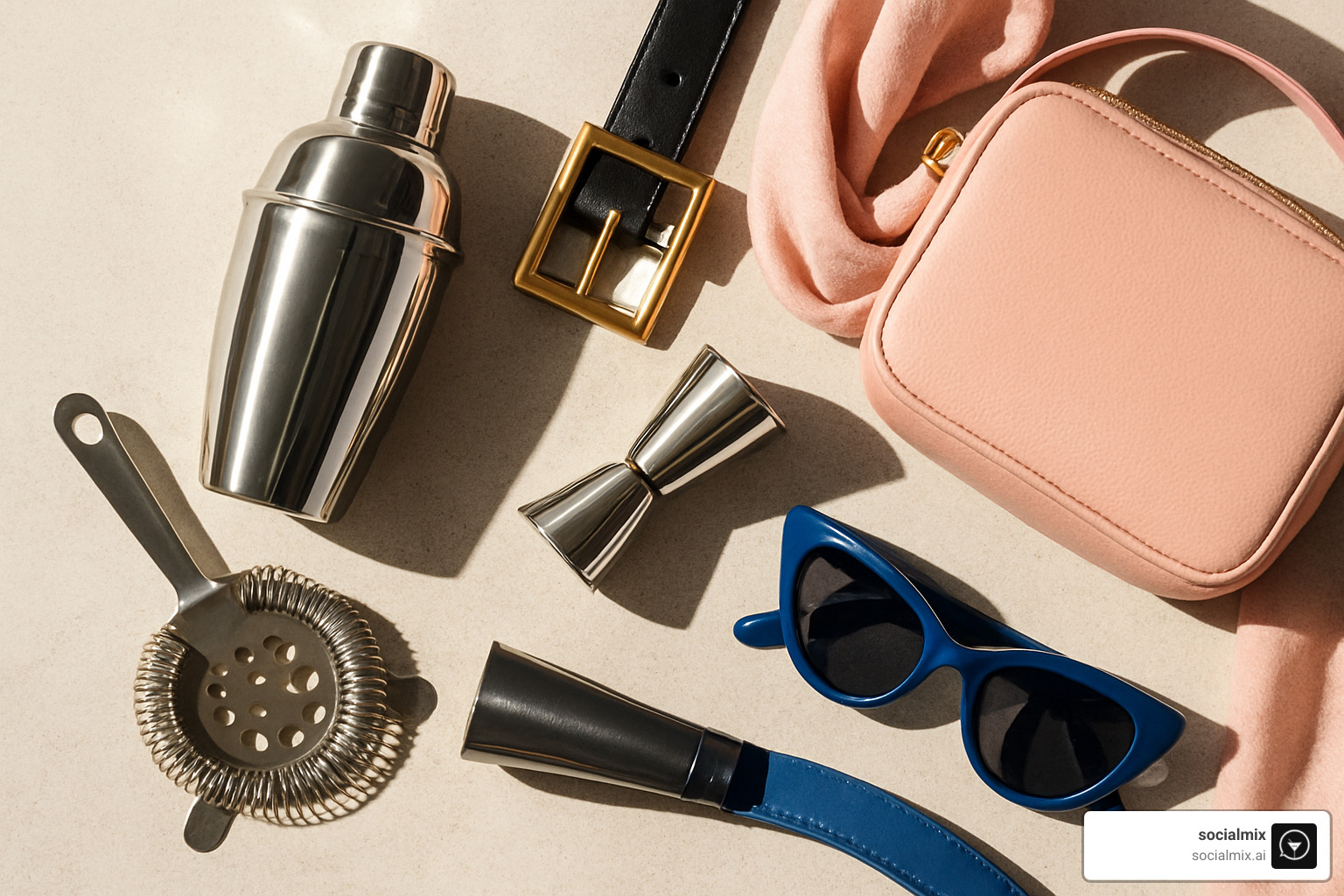
Statement belts with eye-catching hardware are breathing new life into basics, while powder pink emerges as the season's dominant color story. Funnel-neck jackets are making the transition from fall runways to spring-weight versions, offering a sophisticated silhouette that works beautifully for social occasions.
"Blue accessories are having a moment this spring," notes trend research, with affordable options like The Drop Addison Soft Volume Top-Handle Bag ($39.80) offering an accessible entry point. Crochet tops deliver that "carefree, sunshine-filled spring and summer aesthetic" that feels perfectly aligned with warm-weather socializing and outdoor cocktail hours.
Gen Z Values Driving Social Fashion Trends
Beyond specific items, broader value shifts are reshaping fashion, particularly among Gen Z consumers who now represent 30% of the global population with an impressive $360 billion in purchasing power in the US alone.
Research reveals that 66% of Gen Z shoppers willingly pay more for sustainable or environmentally friendly products. This commitment is changing both product development and marketing throughout the industry. "The global secondhand market is expected to nearly double by 2027, reaching a value of $350 billion," highlighting how circular fashion has evolved from niche interest to mainstream movement.
Inclusivity stands as another cornerstone value, with gender-fluid garments and adaptive designs accommodating diverse bodies and abilities gaining well-deserved prominence. Brands showcasing genuine diversity in their marketing consistently see higher engagement and loyalty from this conscious generation.
Individuality shines through in the "vibe-driven aesthetic"—the practice of dressing to reflect your mood rather than following external trends. This approach values personal expression and emotional connection over simply chasing the latest styles.
The hybrid identity trend blends seemingly contradictory elements like oversized casual pieces with custom, refined elements. This "hybrid streetwear-formal fusion" reflects Gen Z's comfort with complexity and multiple identities in both fashion and life.
Items that facilitate community connection, like the friendship bracelets popularized at Taylor Swift concerts, demonstrate how fashion serves as social currency and a meaningful point of connection between people—something we at socialmix deeply value.
Styling Guide: Mixologist-Inspired Looks
At socialmix, we see fascinating parallels between cocktail culture and current social fashion trends. Both worlds celebrate craftsmanship, sensory experience, and that perfect balance between tradition and innovation.
For those looking to blend current trends with mixology-inspired style, try pairing a satin midi skirt with a crochet top for what we call cocktail-hour chic. This textural contrast works beautifully for evening gatherings. Add a statement belt to define the waist and create a polished silhouette perfect for sophisticated social settings.
Incorporate the trending silver jewelry revival with pendant necklaces or layered chains that catch the light like the perfect cocktail garnish. These metallic accents add dimension and interest to simple outfits, drawing the eye just like a well-garnished signature drink.
Accept the smart casual balance with liftd sneakers paired with more structured pieces. This balance of comfort and sophistication mirrors the modern mixologist's approach to classics with a contemporary twist—familiar yet fresh.
For more inspiration on creating the perfect cocktail attire for every occasion, explore our guide to Mix and Match: Fashionable Cocktail Attire for Every Occasion.
Sustainability vs. Fast & Ultra-Fast Fashion
The digital acceleration of social fashion trends has created quite the fashion paradox. While social media has wonderfully democratized style and opened doors for diverse expression, it's also fueled a consumption frenzy through fast and ultra-fast fashion that's hard to ignore.
"Fast fashion magnifies the fast fashion model almost tenfold through influencer collaborations," industry research tells us. Some brands now drop new items almost daily, scrambling to capitalize on viral trends within days of their first TikTok appearance. This breakneck pace comes with serious consequences.
Many of these quickly-produced garments barely survive a year of wear. They're often made with cheaper materials that simply weren't built to last. The rapid production cycle frequently involves questionable labor practices that we'd rather not think about while scrolling through our feeds. And then there's the waste—millions of barely-worn garments ending up in landfills because the trend cycle has compressed from seasons to mere weeks.
As one thoughtful college student shared during research: "Do I really need this item or is it just because it's trending? Will I still use this clothing when the trend ends?" These questions capture the growing tension many of us feel between wanting to participate in trends and consuming responsibly.

But there's hope on the horizon. A powerful sustainability movement is gaining serious momentum across social platforms. Pinterest searches for sustainable fashion have jumped up 71% year-over-year, while eco-conscious hashtags are generating millions of engagements across platforms.
Innovative materials are leading this shift. Brands are exploring exciting alternatives like recycled polyester made from plastic bottles and organic cotton grown without harmful pesticides. Plant-based options like pineapple leather offer animal-free alternatives with significantly lower environmental impacts. Even mushroom-based textiles are making their way into accessories, while upcycled fabrics give new life to post-consumer waste.
Technology is enabling more responsible production too. AI-powered demand forecasting helps reduce overproduction by predicting exactly what consumers will want. Blockchain traceability lets brands verify ethical labor practices throughout their supply chain. Digital sampling minimizes material waste during the design process, and on-demand manufacturing eliminates excess inventory sitting in warehouses.
Balancing Participation & Responsibility in Social Fashion Trends
For those of us wanting to enjoy social fashion trends while minimizing our environmental footprint, several practical approaches have gained traction.
Capsule wardrobes offer a mindful alternative to constant shopping. By building versatile collections of high-quality pieces that work beautifully together, you can reduce the need for constant purchases. This approach values quality over quantity and timeless style over fleeting trends—much like investing in a quality cocktail shaker that will serve you for years rather than a plastic one that cracks after a few uses.
Rental platforms like Rent the Runway have transformed how we think about statement pieces. They allow you to participate in trends without permanent acquisition—perfect for that bold printed dress you might only wear once or twice. "Ask yourself if you'll still use the item once the trend fades to avoid unnecessary purchases," one fashion sustainability expert wisely advises.
Thrift challenges on social media have completely transformed secondhand shopping from necessity to virtue. Young consumers proudly showcase their vintage and thrifted finds, often styling them in fresh, contemporary ways. The global secondhand market is projected to reach a staggering $350 billion by 2027, making it a mainstream alternative to buying new.
A revival of repair culture is happening too. Platforms like TikTok and YouTube have popularized mending, customization, and care techniques that extend garment lifespans. These skills—once common knowledge passed down through generations—are being refinded by younger people concerned about waste and seeking connection to craftsmanship.
Blockchain traceability represents the cutting edge of conscious consumption. These emerging technologies allow shoppers to verify the ethical and environmental credentials of their purchases, creating much-needed accountability throughout the supply chain.
At socialmix, we believe deeply in mindful consumption that prioritizes quality, versatility, and longevity. Our designs draw inspiration from the timeless craft of mixology, where the best tools and techniques improve with age rather than becoming obsolete. Just like a well-made cocktail shaker that develops character over time, we create pieces that transcend fleeting trends while still feeling contemporary and relevant to your social life.
The Future of Social Fashion Trends & Digital Culture
The future of social fashion trends looks incredibly exciting as technology, sustainability concerns, and global cultural exchange create new possibilities. It's like watching the next season of your favorite show—you can see hints of what's coming, but the full story will still surprise you.
AI Virtual Try-On tools are changing how we shop online in amazing ways. Remember the frustration of ordering clothes only to find they don't fit or look nothing like the picture? These new technologies let you see exactly how garments will look on your body before buying. Brands are quickly adopting these tools because they reduce returns and make online shopping more confident and fun.
Smart Fabrics are moving from sci-fi to your closet faster than you might think. Imagine wearing a jacket that adjusts to your body temperature or a shirt that monitors your heart rate during exercise. These textiles add practical benefits beyond just looking good—they actually improve your daily experience.
The Metaverse Wearables market is booming in a way few predicted. People are spending real money—sometimes thousands of dollars—on clothes their avatars wear in virtual worlds. It's fascinating because these digital-only garments satisfy our desire for creativity and self-expression without using physical resources or creating waste.
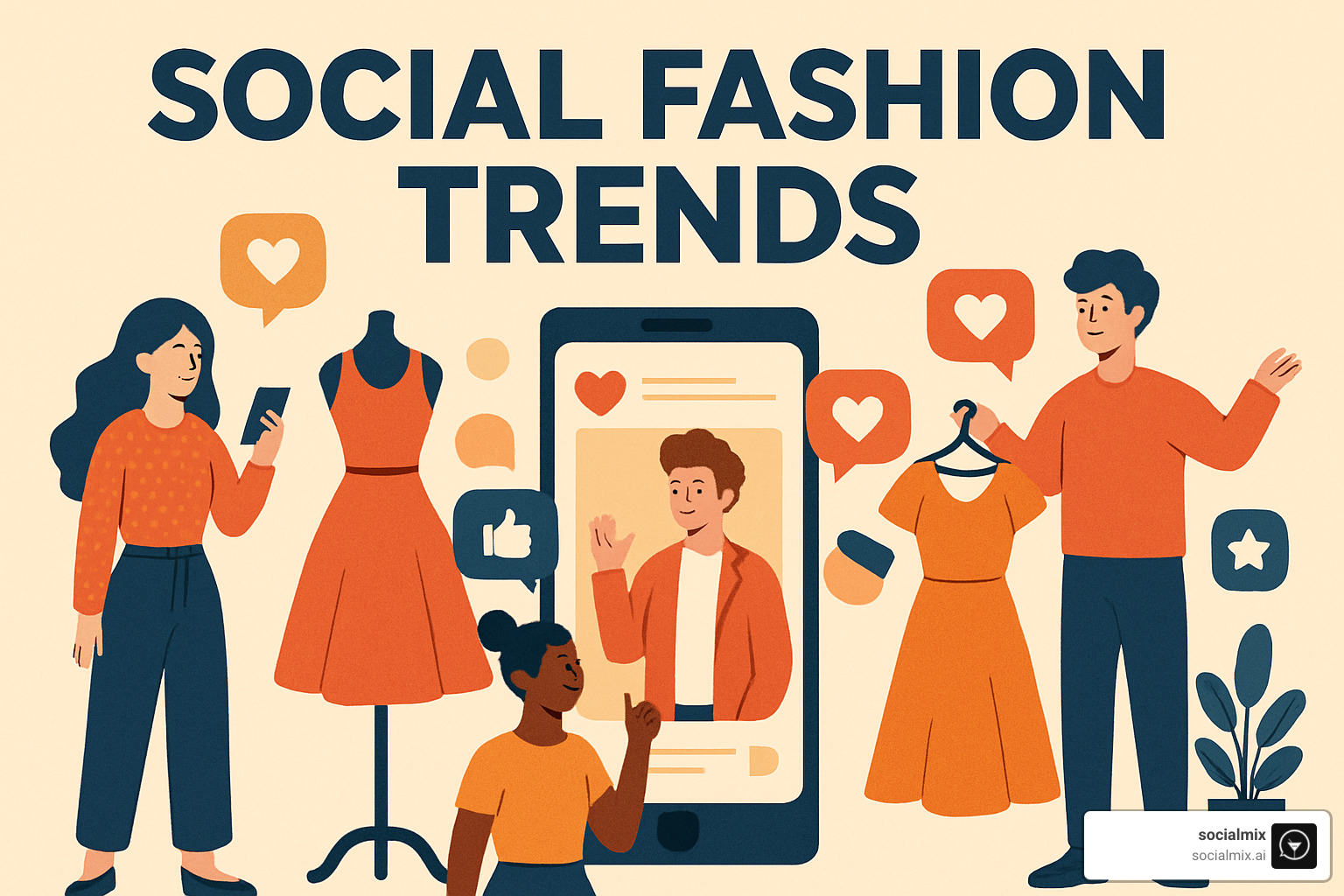
Fashion brands are getting smarter with Predictive Analytics that can forecast trends 6-12 months before they hit mainstream. Instead of frantically chasing viral moments, forward-thinking companies are using social media image analysis to anticipate what consumers will want next season. This shift from "faster" to "smarter" product development is better for both business and sustainability.
Some of the most interesting innovations come from unexpected places. Cross-Industry Collaboration brings fresh perspectives—like Juicy Couture partnering with KRAFT Real Mayo. These surprising mashups create buzz while introducing completely new design ideas that wouldn't emerge from traditional fashion thinking.
Social media has boostd Global Sub-Culture Diffusion, spreading regional styles worldwide at lightning speed. The "Scandi-girl" aesthetic or Japanese streetwear elements now appear in wardrobes everywhere, creating richer and more diverse fashion ecosystems. This cultural exchange makes fashion more interesting and inclusive than ever before.
Roadmap for Brands & Creators
For brands trying to steer this complex landscape, several approaches stand out as particularly effective.
Advanced Social Listening goes far beyond tracking basic hashtags. The most innovative companies use sophisticated image recognition and sentiment analysis to detect emerging social fashion trends before they explode. It's like having fashion radar that sees around corners.
Smart brands are embracing Community Co-Design, involving their audiences directly in the creation process. When customers vote on designs or provide feedback during development, they become invested in the outcome. This approach transforms passive shoppers into active participants who feel personally connected to the products.
The old model of massive seasonal collections is giving way to Limited Drops—smaller, more frequent releases that create excitement while reducing waste. This approach satisfies social media's hunger for novelty while supporting more sustainable practices. It's the fashion equivalent of farm-to-table dining—fresher, more responsive, and less wasteful.
Consumers increasingly demand Transparency Dashboards showing exactly how and where products are made. "Blockchain is emerging as a tool for consumers to verify ethical sourcing and production," research shows. The days of mysterious supply chains are ending as shoppers want the full story behind their purchases.
Perhaps most importantly, Inclusive Sizing is becoming a business necessity rather than an optional extra. Expanding size ranges and adopting adaptive design principles ensures products serve diverse bodies and abilities, reflecting the inclusive values driving many modern social fashion trends.
At socialmix, we're particularly fascinated by how these developments improve the connection between fashion and social experiences. We envision creating pieces that not only look stylish but actually make your social interactions more meaningful—just like a perfectly crafted cocktail serves as both a delicious drink and a catalyst for great conversation.
For more insights on creating timeless style that improves social occasions, check out our guide to Raise the Bar: Timeless Bartender Attire for Every Occasion.
Frequently Asked Questions about Social Fashion Trends
How has social media transformed the trend cycle?
Remember when we used to wait months to see runway styles hit mainstream stores? Those days are long gone! Social media has completely reinvented how fashion trends emerge and spread.
The most dramatic change is simply speed. What once took 1-2 years to move from high fashion to your local mall now happens almost overnight. As one fashion researcher put it, "Short-form social media content has reduced traditional seasonal fashion cycles to weekly turnover." A designer's Instagram post on Monday could inspire thousands of recreations by Friday!
This acceleration comes with a beautiful democratization of fashion. The gatekeepers who once controlled what was "in" (magazine editors, designers, retail buyers) have been joined by everyday style enthusiasts with smartphones and creative ideas. That college student posting creative thrift flips might launch the next global trend before any fashion house catches on.
We're also seeing incredible fragmentation in trends. Rather than everyone following the same few seasonal must-haves, dozens of micro-trends can flourish simultaneously across different platforms and communities. This creates a richer, more diverse fashion landscape where there's truly something for everyone.
Every like, share, and comment leaves a digital footprint, creating unprecedented documentation of how trends evolve. This transparency makes the whole process more self-aware – we're not just participating in trends, we're analyzing them in real-time!
Perhaps most fascinating is the algorithm influence on what catches fire. Those invisible digital forces that determine what appears in your feed can dramatically amplify certain social fashion trends while others fade into obscurity, regardless of their inherent appeal.
What role do influencers play in accelerating trends?
Influencers have become the essential connective tissue in our fashion ecosystem, performing several crucial functions that keep trends flowing.
They're our modern trend scouts, constantly searching for emerging styles from niche communities or vintage references and introducing them to wider audiences. That obscure Japanese streetwear detail or forgotten 70s silhouette might remain hidden until the right influencer spotlights it.
What makes influencers particularly valuable is their skill at translation – showing followers exactly how to incorporate new trends into real-life wardrobes. Rather than just showcasing the trend, they demonstrate styling options, occasion appropriateness, and accessibility factors that help their audience feel confident adopting something new.
Their endorsement provides crucial validation, essentially giving followers permission to try something that might otherwise feel too risky or unfamiliar. This social proof is incredibly powerful in overcoming the natural hesitation many feel toward fashion experimentation.
Each styling video or outfit post creates amplification that multiplies exposure exponentially. When dozens of influencers feature the same trend simultaneously, it creates a tipping point where the style suddenly feels unavoidable.
Interestingly, research shows that "influencers with less than 35,000 followers get the highest engagement rate at 5.3%." This suggests that micro-influencers – those relatable figures who feel more like friends than celebrities – often drive more authentic trend adoption than major stars with millions of followers.
How can I stay sustainable while following social fashion trends?
The tension between trend participation and sustainability is something many of us struggle with. Thankfully, there are thoughtful approaches that let you enjoy fashion's creative evolution without the environmental guilt.
Start by practicing selective adoption. Instead of chasing every viral moment (an exhausting and expensive proposition!), choose only the trends that genuinely resonate with your personal style and lifestyle. Ask yourself: "Does this trend actually feel like me, or am I just responding to social pressure?"
When you do decide to accept a trend, prioritize quality over quantity. A well-made version of a trending item will not only look better but will likely remain wearable long after its moment in the spotlight has passed. This approach treats trends as evolution rather than revolution in your wardrobe.
The booming secondhand market offers a brilliant sustainability solution. "The global secondhand market is expected to nearly double by 2027, reaching a value of $350 billion," and these platforms are treasure troves for finding trend pieces without contributing to new production. Yesterday's micro-trend is today's thrift store gem!
For those statement pieces you'll realistically only wear a handful of times, consider rental options instead of purchase. This approach gives you the fun of trend participation without the long-term commitment or waste.
Get creative with DIY adaptation too! Sometimes a simple accessory swap, creative styling, or minor modification can give existing wardrobe items a trend-relevant update without buying anything new. Those barrel jeans might be achievable with some strategic pinning of pants you already own!
Before any purchase, do a quick value analysis by considering potential cost-per-wear. A $200 trending item you'll wear weekly for a year is actually more economical and sustainable than a $40 fast-fashion version you'll wear twice before it falls apart.
At socialmix, we believe sustainable style and trend participation can absolutely coexist harmoniously. Our philosophy mirrors the best of mixology – thoughtfully combining timeless elements with fresh innovations to create something that feels current without being disposable. Like a perfectly balanced cocktail, good style should be both momentarily delightful and built on enduring principles of quality and craft.
Conclusion
The evolution of social fashion trends represents one of the most fascinating intersections of technology, culture, and commerce in our digital age. What began as a simple shift in how we find new styles has transformed into a complete reimagining of the fashion ecosystem—from creation and distribution to consumption and disposal.
As we've explored throughout this guide, social media has democratized fashion influence, accelerated trend cycles, and created both challenges and opportunities for sustainability. The platforms where we swipe, scroll, and style have become the new runways, showrooms, and fashion communities all rolled into one.
At socialmix, we find particular resonance between this dynamic landscape and our passion for cocktail culture. Just as mixology blends tradition with innovation, respects craftsmanship while embracing experimentation, and creates experiences that bring people together, the best approach to social fashion trends balances appreciation for the new with respect for what endures.
Our mission to curate distinctive collections that seamlessly fuse style with sophistication aligns perfectly with the thoughtful navigation of today's trend ecosystem. By creating pieces that lift social experiences while maintaining quality and versatility, we hope to contribute to a more mindful approach to fashion consumption.
As you explore the ever-changing world of social fashion, we encourage you to:
- Experiment with trends that genuinely speak to your personal style
- Invest in quality pieces that will transcend fleeting moments
- Consider the full lifecycle of your fashion choices
- Use style as a means of connection and self-expression
- Balance novelty with sustainability
For more inspiration on creating memorable style moments that improve social connections, explore our mixologist community and find how the worlds of fashion and mixology can complement each other beautifully.
Cheers to swiping, scrolling, and styling responsibly!




Leave a comment